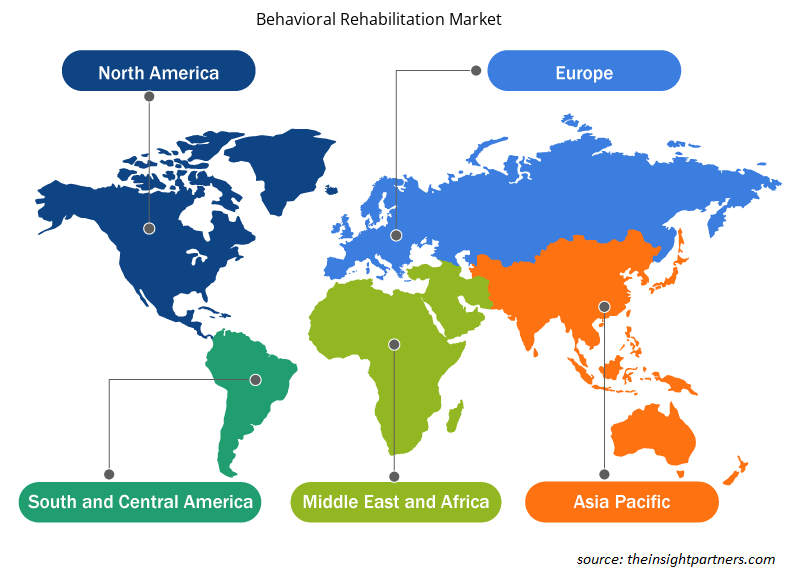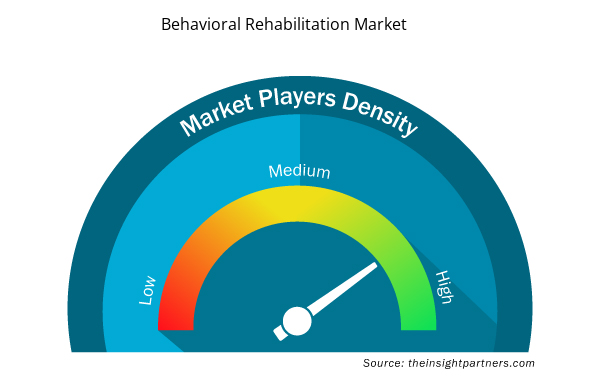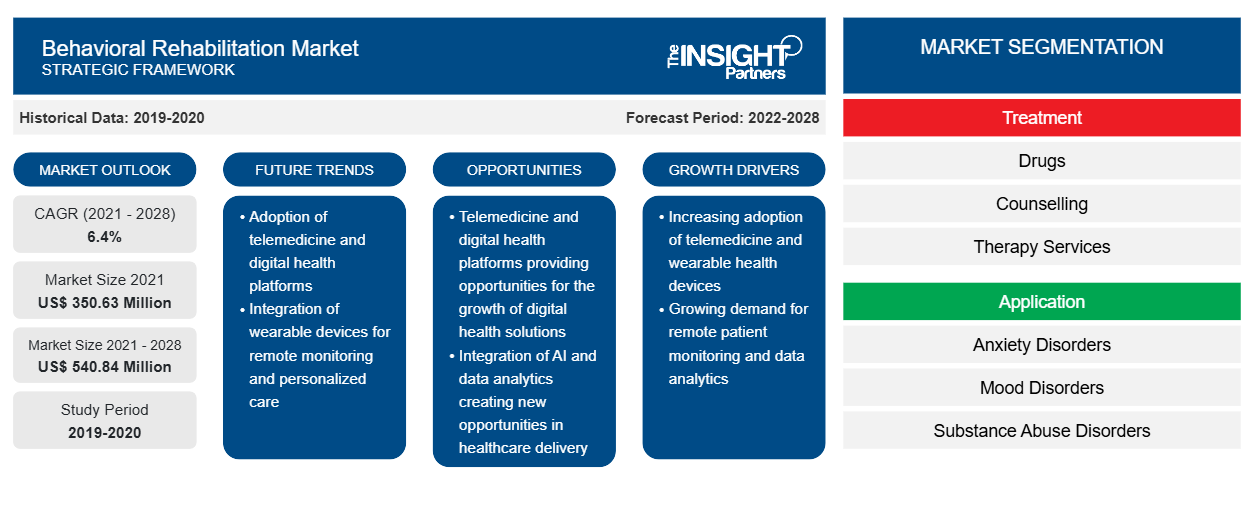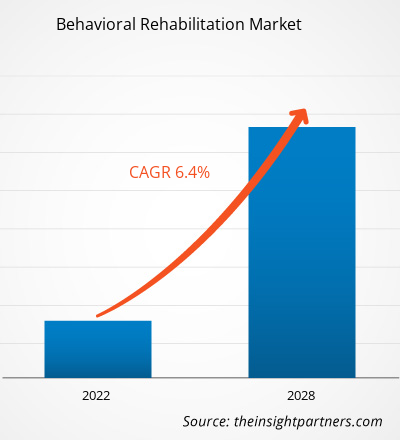Se espera que el mercado de rehabilitación conductual crezca de US$ 350,63 millones en 2021 a US$ 540,84 millones en 2028; se estima que crecerá a una CAGR del 6,4% durante 2021 a 2028.
Las personas pueden caer en diversas adicciones conductuales por diversas razones, lo que afecta gravemente su salud y bienestar a largo plazo. La rehabilitación conductual es una metodología muy utilizada para recuperar a los pacientes de los hábitos conductuales. Las adicciones conductuales son lo mismo que las adicciones al abuso de sustancias. Los pacientes suelen tener que someterse a diferentes cursos metodológicos y medicamentos. Las actividades de rehabilitación conductual se prescriben durante un período prolongado. La terapia de rehabilitación la llevan a cabo profesionales que entienden adicciones específicas.
El aumento de la prevalencia de trastornos del comportamiento, la fácil disponibilidad de terapias de rehabilitación conductual y un aumento en el número de lanzamientos de productos están impulsando el mercado.
Personalice este informe según sus necesidades
Obtendrá personalización en cualquier informe, sin cargo, incluidas partes de este informe o análisis a nivel de país, paquete de datos de Excel, así como también grandes ofertas y descuentos para empresas emergentes y universidades.
- Obtenga las principales tendencias clave del mercado de este informe.Esta muestra GRATUITA incluirá análisis de datos, desde tendencias del mercado hasta estimaciones y pronósticos.
Perspectivas del mercado
Disponibilidad de terapias de rehabilitación conductual
Los trastornos de conducta son un problema común entre niños y adolescentes de todo el mundo. Implican un patrón de conductas disruptivas que duran al menos seis meses y les causan problemas en el hogar, en la escuela y en otras situaciones sociales. Los trastornos de conducta disruptiva (DBD) contribuyen significativamente a la amplia gama de enfermedades que afectan a niños y adolescentes. Los DBD, clasificados como trastornos psiquiátricos , incluyen principalmente el trastorno de conducta (CD) y el trastorno negativista desafiante (ODD).
Según los Centros para el Control y la Prevención de Enfermedades (CDC), el 5,1% de todos los niños estadounidenses de entre 4 y 17 años han sido diagnosticados con graves problemas emocionales o de conducta por sus padres. Los trastornos emocionales y de conducta afectan a entre el 10 y el 15% de los niños en todo el mundo, según un informe reciente del Instituto Nacional de Salud Mental (NIMH). Otro trastorno de conducta común, el trastorno obsesivo-compulsivo (TOC), afecta a alrededor del 2-3% de las personas en los EE. UU. Entre los adultos, el número de mujeres afectadas es ligeramente superior al de hombres. El TOC suele comenzar en la infancia, la adolescencia o la adultez temprana; la edad promedio en la que aparecen los síntomas es de 19 años.
Muchas investigaciones demuestran que la adicción y la depresión son tratables. El Instituto Nacional sobre el Abuso de Drogas (NIDA), que respalda más del 85% de las investigaciones mundiales sobre el abuso de drogas y la adicción, ha descubierto que los servicios de terapia de asesoramiento son el enfoque de tratamiento más eficaz. Los tratamientos para los trastornos de conducta se centran principalmente en el tratamiento conductual y la medicación. La formación para padres y la terapia familiar se consideran bastante eficaces para controlar los trastornos de conducta. El tratamiento de terapia cognitiva conductual ha surgido como el mecanismo más utilizado para controlar los síntomas de los trastornos de conducta.
Perspectivas basadas en aplicaciones
Según la aplicación, el mercado de rehabilitación conductual se segmenta en trastornos de ansiedad, trastornos del estado de ánimo, trastornos por abuso de sustancias, trastornos de la personalidad y trastornos por déficit de atención. El segmento de trastornos de ansiedad tuvo la mayor participación de mercado en 2021 y se prevé que registre la CAGR más alta del mercado durante el período de pronóstico.
Perspectivas basadas en el tratamiento
En términos de tratamiento, el mercado de rehabilitación conductual se segmenta en medicamentos y servicios de asesoramiento y terapia. El segmento de servicios de asesoramiento y terapia tuvo la mayor participación de mercado en 2021 y se prevé que registre la CAGR más alta del mercado durante el período de pronóstico.
Perspectivas basadas en el entorno sanitario
Según el entorno sanitario, el mercado de rehabilitación conductual se segmenta en rehabilitación conductual ambulatoria, rehabilitación conductual hospitalaria y rehabilitación conductual residencial. El segmento de rehabilitación conductual ambulatoria tuvo la mayor participación de mercado en 2021 y se prevé que registre la CAGR más alta del mercado durante el período de pronóstico.
Los lanzamientos de productos son la estrategia más comúnmente adoptada por las empresas para expandir su presencia y carteras de productos en el mercado. Además, las empresas han implementado varias estrategias inorgánicas, como fusiones y adquisiciones, y asociaciones. Por ejemplo, en marzo de 2019, la FDA aprobó el aerosol nasal Spravato (esketamina) de Johnson & Johnson Health Care Systems Inc. para tratar la depresión en adultos.
Perspectivas regionales del mercado de rehabilitación conductual
Los analistas de Insight Partners explicaron en detalle las tendencias y los factores regionales que influyen en el mercado de rehabilitación conductual durante el período de pronóstico. Esta sección también analiza los segmentos y la geografía del mercado de rehabilitación conductual en América del Norte, Europa, Asia Pacífico, Oriente Medio y África, y América del Sur y Central.

- Obtenga datos regionales específicos para el mercado de rehabilitación conductual
Alcance del informe de mercado de rehabilitación conductual
| Atributo del informe | Detalles |
|---|---|
| Tamaño del mercado en 2021 | US$ 350,63 millones |
| Tamaño del mercado en 2028 | US$ 540,84 millones |
| CAGR global (2021-2028) | 6,4% |
| Datos históricos | 2019-2020 |
| Período de pronóstico | 2022-2028 |
| Segmentos cubiertos | Por tratamiento
|
| Regiones y países cubiertos | América del norte
|
| Líderes del mercado y perfiles de empresas clave |
|
Densidad de actores del mercado de rehabilitación conductual: comprensión de su impacto en la dinámica empresarial
El mercado de rehabilitación conductual está creciendo rápidamente, impulsado por la creciente demanda de los usuarios finales debido a factores como la evolución de las preferencias de los consumidores, los avances tecnológicos y una mayor conciencia de los beneficios del producto. A medida que aumenta la demanda, las empresas amplían sus ofertas, innovan para satisfacer las necesidades de los consumidores y aprovechan las tendencias emergentes, lo que impulsa aún más el crecimiento del mercado.
La densidad de actores del mercado se refiere a la distribución de las empresas o firmas que operan dentro de un mercado o industria en particular. Indica cuántos competidores (actores del mercado) están presentes en un espacio de mercado determinado en relación con su tamaño o valor total de mercado.
Las principales empresas que operan en el mercado de rehabilitación conductual son:
- Compañía Springstone, Inc.
- Centros de Adicción Estadounidenses
- Atención sanitaria Acadia
- Servicios de Salud Universal, Inc.
- Salud Magallanes, Inc.
Descargo de responsabilidad : Las empresas enumeradas anteriormente no están clasificadas en ningún orden particular.

- Obtenga una descripción general de los principales actores clave del mercado de rehabilitación conductual
Perfiles de empresas
- Compañía Springstone, Inc.
- Centros de Adicción Estadounidenses
- Acadia Healthcare, Servicios de Salud Universal, Inc.
- Salud Magallanes, Inc.
- Atención médica conductual Haven, Inc.
- Soluciones psicológicas, Inc.
- Compañía: BHG Holdings, LLC.
- Sistema de salud conductual de Aurora
- Centro médico regional Baxter
- Análisis histórico (2 años), año base, pronóstico (7 años) con CAGR
- Análisis PEST y FODA
- Tamaño del mercado Valor/volumen: global, regional, nacional
- Industria y panorama competitivo
- Conjunto de datos de Excel


- Health Economics and Outcome Research (HEOR) Services Market
- Emergency Department Information System (EDIS) Market
- Personality Assessment Solution Market
- Fish Protein Hydrolysate Market
- MEMS Foundry Market
- Vision Guided Robotics Software Market
- E-Bike Market
- Asset Integrity Management Market
- Organoids Market
- Molecular Diagnostics Market

Report Coverage
Revenue forecast, Company Analysis, Industry landscape, Growth factors, and Trends

Segment Covered
This text is related
to segments covered.

Regional Scope
North America, Europe, Asia Pacific, Middle East & Africa, South & Central America

Country Scope
This text is related
to country scope.
Preguntas frecuentes
The behavioral rehabilitation market. People may get into several behavioral addictions for various reasons, severely affecting their health and well-being from a long-term perspective. Behavioral rehabilitation is a fiercely used methodology to retrieve patients from behavioral habits. Behavioral addictions are the same as substance misuse addictions and usually need them to undergo different methodological courses and medications. Behavioral rehabilitation activities are prescribed for an extended period. Rehabilitation therapy is implemented by professionals who understand specific addictions.
The factors that are driving and restraining factors that will affect the behavioral rehabilitation market in the coming years. Factors such as the increasing prevalence of behavioral disorders, rising numbers of product launches and easy availability of behavioral rehabilitation therapies. However, the impact of stigma attached to behavioral disorders is expected to hampers the behavioral rehabilitation market.
The behavioral rehabilitation market based on treatment is segmented into counseling therapy services and drugs. In 2021, the counseling therapy services segment accounted for the highest share, moreover, the same segment is expected to grow at a CAGR of 6.7% in the forecast period.
The behavioral rehabilitation market Springstone, Inc, American Addiction Centers, Acadia Healthcare, Universal Health Services, Inc., Magellan Health, Inc., Haven Behavioral Healthcare, Inc., Psychsolutions, Inc., BHG Holdings, LLC., Aurora Behavioral Health System, and Baxter Regional Medical Center.
Trends and growth analysis reports related to Life Sciences : READ MORE..
The List of Companies - Behavioral Rehabilitation Market
- Springstone, Inc.
- American Addiction Centers
- Acadia Healthcare
- Universal Health Services, Inc.
- Magellan Health, Inc.
- Haven Behavioral Healthcare, Inc.
- PsychSolutions, Inc.
- BHG Holdings, LLC.
- Aurora Behavioral Health System
- Baxter Regional Medical Center
The Insight Partners performs research in 4 major stages: Data Collection & Secondary Research, Primary Research, Data Analysis and Data Triangulation & Final Review.
- Data Collection and Secondary Research:
As a market research and consulting firm operating from a decade, we have published and advised several client across the globe. First step for any study will start with an assessment of currently available data and insights from existing reports. Further, historical and current market information is collected from Investor Presentations, Annual Reports, SEC Filings, etc., and other information related to company’s performance and market positioning are gathered from Paid Databases (Factiva, Hoovers, and Reuters) and various other publications available in public domain.
Several associations trade associates, technical forums, institutes, societies and organization are accessed to gain technical as well as market related insights through their publications such as research papers, blogs and press releases related to the studies are referred to get cues about the market. Further, white papers, journals, magazines, and other news articles published in last 3 years are scrutinized and analyzed to understand the current market trends.
- Primary Research:
The primarily interview analysis comprise of data obtained from industry participants interview and answers to survey questions gathered by in-house primary team.
For primary research, interviews are conducted with industry experts/CEOs/Marketing Managers/VPs/Subject Matter Experts from both demand and supply side to get a 360-degree view of the market. The primary team conducts several interviews based on the complexity of the markets to understand the various market trends and dynamics which makes research more credible and precise.
A typical research interview fulfils the following functions:
- Provides first-hand information on the market size, market trends, growth trends, competitive landscape, and outlook
- Validates and strengthens in-house secondary research findings
- Develops the analysis team’s expertise and market understanding
Primary research involves email interactions and telephone interviews for each market, category, segment, and sub-segment across geographies. The participants who typically take part in such a process include, but are not limited to:
- Industry participants: VPs, business development managers, market intelligence managers and national sales managers
- Outside experts: Valuation experts, research analysts and key opinion leaders specializing in the electronics and semiconductor industry.
Below is the breakup of our primary respondents by company, designation, and region:

Once we receive the confirmation from primary research sources or primary respondents, we finalize the base year market estimation and forecast the data as per the macroeconomic and microeconomic factors assessed during data collection.
- Data Analysis:
Once data is validated through both secondary as well as primary respondents, we finalize the market estimations by hypothesis formulation and factor analysis at regional and country level.
- Macro-Economic Factor Analysis:
We analyse macroeconomic indicators such the gross domestic product (GDP), increase in the demand for goods and services across industries, technological advancement, regional economic growth, governmental policies, the influence of COVID-19, PEST analysis, and other aspects. This analysis aids in setting benchmarks for various nations/regions and approximating market splits. Additionally, the general trend of the aforementioned components aid in determining the market's development possibilities.
- Country Level Data:
Various factors that are especially aligned to the country are taken into account to determine the market size for a certain area and country, including the presence of vendors, such as headquarters and offices, the country's GDP, demand patterns, and industry growth. To comprehend the market dynamics for the nation, a number of growth variables, inhibitors, application areas, and current market trends are researched. The aforementioned elements aid in determining the country's overall market's growth potential.
- Company Profile:
The “Table of Contents” is formulated by listing and analyzing more than 25 - 30 companies operating in the market ecosystem across geographies. However, we profile only 10 companies as a standard practice in our syndicate reports. These 10 companies comprise leading, emerging, and regional players. Nonetheless, our analysis is not restricted to the 10 listed companies, we also analyze other companies present in the market to develop a holistic view and understand the prevailing trends. The “Company Profiles” section in the report covers key facts, business description, products & services, financial information, SWOT analysis, and key developments. The financial information presented is extracted from the annual reports and official documents of the publicly listed companies. Upon collecting the information for the sections of respective companies, we verify them via various primary sources and then compile the data in respective company profiles. The company level information helps us in deriving the base number as well as in forecasting the market size.
- Developing Base Number:
Aggregation of sales statistics (2020-2022) and macro-economic factor, and other secondary and primary research insights are utilized to arrive at base number and related market shares for 2022. The data gaps are identified in this step and relevant market data is analyzed, collected from paid primary interviews or databases. On finalizing the base year market size, forecasts are developed on the basis of macro-economic, industry and market growth factors and company level analysis.
- Data Triangulation and Final Review:
The market findings and base year market size calculations are validated from supply as well as demand side. Demand side validations are based on macro-economic factor analysis and benchmarks for respective regions and countries. In case of supply side validations, revenues of major companies are estimated (in case not available) based on industry benchmark, approximate number of employees, product portfolio, and primary interviews revenues are gathered. Further revenue from target product/service segment is assessed to avoid overshooting of market statistics. In case of heavy deviations between supply and demand side values, all thes steps are repeated to achieve synchronization.
We follow an iterative model, wherein we share our research findings with Subject Matter Experts (SME’s) and Key Opinion Leaders (KOLs) until consensus view of the market is not formulated – this model negates any drastic deviation in the opinions of experts. Only validated and universally acceptable research findings are quoted in our reports.
We have important check points that we use to validate our research findings – which we call – data triangulation, where we validate the information, we generate from secondary sources with primary interviews and then we re-validate with our internal data bases and Subject matter experts. This comprehensive model enables us to deliver high quality, reliable data in shortest possible time.


 Obtenga una muestra gratuita de este informe
Obtenga una muestra gratuita de este informe